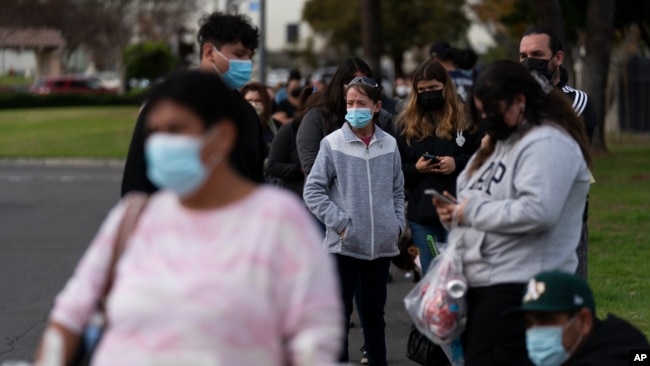オミクロン 後の変異種
これ以上の変異種・・・もうごめんです!
今となっては、根元の解明がうやむやになっています。
もう2年。失われた2年。
VOAで英語を学び、世界の今を見つめましょう!!
専門家 :オミクロンの後にさらなるバリエーションが生まれる可能性(和訳)
Experts: More Variants after Omicron Likely
Jan.36,2022
科学者たちは、急速に拡大するオミクロンはコロナウイルスの最後の心配の種にはならないだろうと警告しています。
オミクロン型コロナウイルスは、11月中旬に初めて確認されました。1月の第1週までに、WHOはCOVID-19の新規感染者数が1,500万人を記録したと報告しています。これは前週から55%も増加したことになります。
新しい感染者が出るたびに、ウイルスが変異、つまり変化するチャンスがあるのです。オミクロンが急速に広まったということは、ウイルスが変種と呼ばれる新しいバージョンを開発する機会が増えたということです。
科学者たちは次の変種がどのようなものなのか、またそれがパンデミックをどのように形成するかは分かっていません。しかし、新しいコロナウイルスの変種が軽い病気を引き起こすという保証はありませんし、既存のワクチンがそれらに効くという保証もないと言うのです。そして、予防接種がまだ有効であるうちに、今すぐ広くワクチン接種を行うよう促しています。
レオナルド・マルティネス博士は、ボストン大学の感染症専門家である。彼は、「オミクロンが早く広がれば広がるほど、突然変異の機会が多くなり、より多くの変種を生み出す可能性があります」と述べています。
より多くの伝染性、画期的な感染症
オミクロンは、デルタ型と比べると少なくとも2倍、オリジナル版と比べると4倍の感染力があることが研究により明らかになっています。感染力が強いということは、人と人との間を容易に行き来できることを意味します。
また、オミクロンはデルタよりも、以前にCOVID-19に感染した人に再感染する可能性が高く、”ブレイクスルー感染” - ワクチンを接種していても感染すること-を引き起こす可能性があります。
この変種はすぐに広がるため、免疫系が弱っている人に感染して体内に留まりる可能性が高く-突然変異や変化を起こす時間が長くなる可能性があります。
ジョンズ・ホプキンス大学のスチュアート・キャンベル・レイ博士は、「新しい変種の温床になりそうなのは、より長い感染期間です 」と述べています。彼はまた、より多くの感染がその可能性を高めると付け加えています。
その他のウイルスの可能性
オミクロンはデルタよりも重症化しにくいようなので、風邪のように穏やかなウイルスになるのではと期待されています。ウイルスが宿主を非常に早く殺してしまうと、うまく拡散しないことを考えると、その可能性はあると専門家は言います。しかし、ウイルスは時間が経つと死因が少なくなるとは限りません。
レイ博士は、変種が最初に軽い感染症を引き起こし、その後重症化すれば、その主な目的である複製や繁殖を実現することができると説明しています。そうすれば、感染者が重症化する前に、他の人にウイルスを広める時間ができてしまいます。
レイ氏はさらに、「ウイルスが時間とともに致死量を減らしていくという確信は持てない。」と付け加えます。 lethal(リーサル)とは、致命的という意味の言葉です。
COVID-19の原因ウイルスであるSARS-CoV-2が最初に出現したとき、誰も免疫を持っていませんでした。しかし、感染症やワクチンによって少なくとも世界の多くの人々が免疫を獲得しているため、ウイルスが生き残り、他の人々に広まるためには、ウイルスは変化しなければなりません。
このような変化には多くの可能性があります。
動物が新しい変種を放つ可能性があります。犬や猫、鹿、養殖のミンクなどがウイルスに感染する可能性がある動物です。ウイルスは彼らの中で変異し、また人に飛び火する可能性があります。
もう一つの可能性は、人がオミクロンとデルタの両方に同時に感染することです。このような感染によって、レイ博士が“Frankenvariants””フランケンヴァリアント”と呼ぶ、両方の変異の性質を持ったものが作られる可能性があります。
新しい変種が発生した場合、どの変種が広がるかを知ることはまだ非常に困難であると科学者たちは言います。例えば、オミクロンはヒトの細胞に付着しやすいように30もの変異があります。しかしフランスで発見されたIHUの変異型は46の変異を持っておるのですが、全く広がっていないようです。
科学者たちは、新しい変異型の拡散を制御したり制限したりするために、顔を覆うものを身につけたり予防接種を受けたりといった公衆衛生対策を続けることを強調しています。
ルイス・マンスキー氏はミネソタ大学分子ウイルス学研究所の所長です。彼は、ワクチン接種を受けていない人が多いので、"ウイルスはまだ何が起こっているのかをコントロールしているようなものだ "と言っています。
Experts: More Variants after Omicron Likely
Scientists warn that the fast-spreading Omicron will likely not be the last worrisome version of the coronavirus.
The Omicron version of the coronavirus was first identified in mid-November. By the first week of January, the World Health Organization reported a record 15 million new COVID-19 cases. That is a 55 percent increase from the previous week.
Every new infection provides a chance for the virus to mutate, or change. The fast spread of Omicron means the virus has more chances to develop new versions, called variants.
Scientists do not know what the next variants will look like or how they might shape the pandemic. But they say there is no guarantee that new coronavirus variants will cause milder illness or that existing vaccines will work against them. And they urge wider vaccination now, while the shots still work against the virus.
Dr. Leonardo Martinez is an infectious disease expert at Boston University. He said, “The faster Omicron spreads, the more opportunities there are for mutation, potentially leading to more variants.”
More contagious, breakthrough infections
Research shows that Omicron is at least two times as contagious as the Delta variant and four times more contagious than the original version of the virus. Contagious means the variant could easily pass between people.
Omicron is also more likely than Delta to reinfect individuals who previously had COVID-19 and to cause “breakthrough infections” - meaning to cause an infection even if a person is vaccinated.
The variant’s quick spread increases the chances that the virus will infect and remain inside people with weakened immune systems - giving it more time to develop mutations or changes.
Dr. Stuart Campbell Ray of Johns Hopkins University said, “It’s the longer...infections that seem to be the most likely breeding grounds for new variants.” He added more infections also increased the chances for that to happen.
Other possibilities for the virus
Since Omicron appears to cause less severe disease than Delta, there is hope that it could make the virus milder like a common cold. It is a possibility, experts say, given that viruses do not spread well if they kill their hosts very quickly. But viruses do not always get less deadly over time.
Ray explained that a variant could realize its main goal – replicating or reproducing – if it caused mild infections at first then caused severe illness later. This would give time for an infected person to spread the virus to others before getting very sick.
Ray added, “I don’t think we can be confident that the virus will become less lethal over time.” Lethal is a term that means deadly.
When SARS-CoV-2, the virus that caused COVID-19, first appeared, no one was immune. But infections and vaccines have given at least some immunity to much of the world, so the virus must change to survive and spread to others.
There are many possible ways for such change to take place.
Animals could possibly release new variants. Dogs and cats, deer and farm-raised mink are some of the animals that could be infected by the virus. The virus could mutate within them and then jump back to people.
Another possibility is that people could get infected with both Omicron and Delta at the same time. Such infections could create what Ray calls “Frankenvariants” with qualities of both variants.
When new variants do develop, scientists said it is still very difficult to know which ones might spread. For example, Omicron has 30 mutations that let it attach easily to human cells. But the IHU variant, identified in France, has 46 mutations and does not seem to have spread much at all.
To control or limit the spread of new variants, scientists stress continuing with public health measures such as wearing face coverings and getting vaccinated.
Louis Mansky is director of the Institute for Molecular Virology at the University of Minnesota. He said with so many unvaccinated people, “the virus is still kind of in control of what’s going on.”
Words in This Story
opportunity – n. an amount of time or a situation in which something can be done
mutation – n. biology : a change in the genes of a plant or animal that causes characteristics that are different from what is normal; a new form of something that has changed
contagious – adj. able to be passed from one person or animal to another by touching
immune system– n. the system that protects your body from diseases and infections


